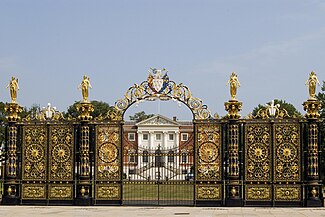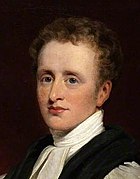Portal:Cheshire
|
The Cheshire Portal
WelcomeCheshire Plain from the Mid Cheshire Ridge
Cheshire is a ceremonial county in the North West of England. Chester is the county town, and formerly gave its name to the county. The largest town is Warrington, and other major towns include Congleton, Crewe, Ellesmere Port, Macclesfield, Nantwich, Northwich, Runcorn, Sandbach, Widnes, Wilmslow and Winsford. The county is administered as four unitary authorities. Cheshire occupies a boulder clay plain (pictured) which separates the hills of North Wales from the Peak District of Derbyshire. The county covers an area of 2,343 km2 (905 sq mi), with a high point of 559 m (1,834 ft) elevation. The estimated population is a little over one million, 19th highest in England, with a population density of around 450 people per km2. The county was created in around 920, but the area has a long history of human occupation dating back to before the last Ice Age. Deva was a major Roman fort, and Cheshire played an important part in the Civil War. Predominantly rural, the county is historically famous for the production of Cheshire cheese, salt and silk. During the 19th century, towns in the north of the county were pioneers of the chemical industry, while Crewe became a major railway junction and engineering facility. Selected articleAdlington Hall is a grade-I-listed country house in the village of Adlington. The Legh family has lived on the site since the early 14th century. The hall follows a courtyard plan. The medieval Great Hall was built in 1480–1505 with a timber frame; it has a hammer-beam roof, a rare wooden canopy dated 1505, and an organ dating from the late 17th century, which was played by Handel, a friend of the Legh family. The Great Hall was encased in brick after the Civil War, when the hall was twice occupied by Parliamentary forces. The east wing dates from 1581, and retains its original "black and white" appearance. The remainder of the house largely dates from the 18th century, when Charles Legh transformed the hall into a Georgian manor. The grounds were laid out as gardens, woodland and parkland in the 18th century; they are listed at Grade II*. They include Shell House, which has an interior decorated with shells and coloured mirrors, and Tig House, a pavilion which is an early example of the Chinoiserie style. The hall and grounds remain in private ownership, and are occasionally open to the public. Selected imageWarrington Town Hall, built in 1750, was formerly the Georgian country mansion of Bank Hall. It was sold to Warrington council in 1870. The elaborately ornamented gateway, known as the Golden Gates, was exhibited at the London Exhibition of 1862. Credit: Racklever (22 July 2006) In this monthNovember 1867: Grosvenor Park, Chester (pictured) opened. 1 November 1831: Harry Atkinson, Premier of New Zealand, born in Broxton. 4 November 1553: Lawyer Roger Wilbraham born in Nantwich. 7 November 1805: Railway builder Thomas Brassey born in Bulkeley. 11 November 1662: Lawyer John Chesshyre born in Halton. 14 November 1762: Tarporley Hunt Club first met. 15 November 1941: Author Heathcote Williams born in Helsby. 22 November 1961: Pianist Stephen Hough born in Heswall. 24 November 1935: Cyclist Vin Denson born in Chester. 24 November 1955: Cricketer Ian Botham born in Heswall. 26 November 1574: River Weaver in Nantwich flooded, affecting 40 dwellings and 24 salthouses. 29 November 1933: Musician John Mayall born in Macclesfield. Selected listThe output of Chester-based architect John Douglas (1830–1911) included 40 new churches, as well as work on existing churches and church furniture. The majority of his works were in Cheshire and North Wales. His architectural styles were eclectic, but as he worked during the Gothic Revival period much of his output incorporates elements of the English Gothic style. His new churches (St Wenefrede's, Bickley pictured) date from the early 1860s until his death. They are in a range of materials including sandstone and red and other coloured brick; a few examples use half-timbering. His church restorations were influenced by the Oxford Movement, which advocated a shift in emphasis from preaching to the sacrament of the Eucharist, and thus from the pulpit to the altar. Consequences of this included moving the pulpit from a more central position to the side of the church, replacing box pews with open pews, creating a central aisle to give a better view of the altar, and removing galleries; a larger chancel was also required for the associated ritual. One of the hallmarks of Douglas' designs is the attention to detail, especially in wooden articles, and his church furniture often incorporates highly detailed wood carving. GeographyTop: Map of modern Cheshire showing urban areas (grey) and the major road network. Chester (red) is the county town, and Warrington has the greatest population. Towns with more than 10,000 inhabitants in 2011 are highlighted; the size of dot gives a rough indication of the relative population. Wales and the adjacent English counties are shown in capitals. Bottom: Relief map showing the major hills. The Mid Cheshire Ridge is a discontinuous ridge of low hills running north–south from Beacon Hill (north of Helsby Hill) to Bickerton Hill. Most other high ground falls within the Peak District in the east of the county. Shining Tor (559 metres), on the boundary with Derbyshire, forms the county's high point. Administration The ceremonial county of Cheshire is administered by four unitary authorities (click on the map for details): 2 – Cheshire East 3 – Warrington 4 – Halton In the local government reorganisation of 1974, Cheshire gained an area formerly in Lancashire including Widnes and Warrington. The county lost Tintwistle to Derbyshire, part of the Wirral Peninsula to Merseyside, and a northern area including Stockport, Altrincham, Sale, Hyde, Dukinfield and Stalybridge to Greater Manchester. Selected biographyReginald Heber (21 April 1783 – 3 April 1826) was a clergyman, biographer and hymn-writer, who was born in Malpas. After his ordination in 1807, he served as rector of Hodnet for sixteen years. During this period he wrote a biography of the 17th-century cleric Jeremy Taylor, as well as 57 hymns. Only a handful of these remain in use, including "Holy, Holy, Holy" and "Brightest and best of the sons of the morning". His missionary hymn "From Greenland's icy mountains" was formerly popular, but became controversial in the 20th century for its lack of sensitivity to non-Christian beliefs. A fervent supporter of missionary aims, Heber served as the Anglican Bishop of Calcutta from 1823 until his death. He travelled widely within India and worked hard to improve both spiritual and general living conditions within his diocese. After his death in Trichinopoly, monuments were erected to his memory in St Paul's Cathedral and in India. Bishop Heber High School in his home town of Malpas was named for him. Did you know...
Selected town or villageRuncorn is an industrial town and cargo port in the borough of Halton. It stands on the southern bank of the River Mersey where the estuary narrows to form Runcorn Gap, spanned by the Silver Jubilee Bridge (pictured) and the Mersey Gateway. The Manchester Ship Canal runs between the town and the Mersey, and is joined by the Bridgewater Canal. The earliest reference to the settlement is in the Anglo-Saxon Chronicle as Rumcofan, meaning "a wide cove or bay". A small, isolated village until the coming of the Industrial Revolution, various industries developed in Runcorn during the 19th century, in particular, soap and alkali manufacture, quarrying, shipbuilding, engineering and tanning. Only the chemical industry remains important, and diversification has been driven by good access to the transport network. A new town was built to the east of the existing town in the 1960s and 1970s which, together with later developments further east, has resulted in the population doubling to more than 60,000. In the news29 October, 1 November: Warrington council and the mayor of Crewe each announce plans to bid for city status in 2022. 13–14 October: Prince Edward visits Chester and opens a Fire Service training centre in Winsford. 8 October: Castle Street shopping area in Macclesfield reopens after refurbishment. 4 October: Restoration of the grade-I-listed Bridgegate, part of Chester city walls, is completed. 25 September: A bronze frieze by the sculptor Tom Murphy is unveiled in Warrington, as a memorial to the band Viola Beach. 9 September: The fifth stage of the Tour of Britain cycle race takes place in Cheshire, starting at Alderley Park and finishing in Warrington. 24 July: The grade-II-listed Crewe Market Hall (pictured) formally reopens after refurbishment. 15 July: Crewe, Runcorn and Warrington are awarded potential funding under the "Town Deal" government scheme. QuotationChester is a glorious ancient city with a rare elegance in its beautifully preserved old buildings. A sense that all England's history is encapsulated here in its broad, cobbled, enchanting streets and from its 2000 year old walls to the awesome cathedral. Yet it is surprisingly young and lively. A living city with a zing in the air, yet mature and relaxed, a city that knows itself to be happy in its skin. This is the city I grew up in and loved. From Life of Dickens by Graham Laud (1939)
Subcategories
TopicsRecommended articlesThings you can do
WikiProject Related portalsAssociated WikimediaThe following Wikimedia Foundation sister projects provide more on this subject:
Discover Wikipedia using portals |







































